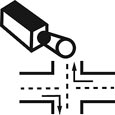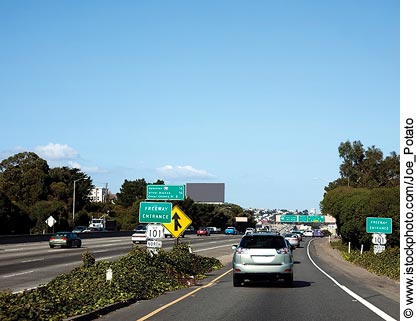U.S. Department of Transportation
Federal Highway Administration
1200 New Jersey Avenue, SE
Washington, DC 20590
202-366-4000
Federal Highway Administration Research and Technology
Coordinating, Developing, and Delivering Highway Transportation Innovations
| FACT SHEET |
| This fact sheet is an archived publication and may contain dated technical, contact, and link information |
| Publication Number: FHWA-HRT-14-045 Date: February 2014 |
Publication Number: FHWA-HRT-14-045 Date: February 2014 |
 |
The Exploratory Advanced Research Program Fact SheetExploratory Advanced Research . . . Next Generation Transportation Solutions |

|
| This is a merge sign by the road side with sky as background. |
One of the major traffic bottlenecks and safety concerns on today’s busy roads occurs during freeway merges. “Advanced Freeway Merge Assistance: Harnessing the Potential of Connected Vehicles” is an Exploratory Advanced Research (EAR) Program project designed to improve the efficiency and safety of freeway merges using connected vehicle technology. This project was awarded by the Federal Highway Administration (FHWA) in 2009, and was conducted by the University of Virginia Center for Transportation Studies (UVA CTS). |
The Connected Vehicles Program is an initiative designed to enable wireless communications among vehicles, the highway infrastructure, and travelers’ personal communications devices. UVA CTS aimed to develop and evaluate candidate freeway merge assistance systems that might significantly improve operations in a connected-vehicle environment. UVA CTS created a connected vehicle traffic simulation tool over a 3-year development process with funding from the National Science Foundation, FHWA, and the Virginia and California Departments of Transportation.
Using a previous 2008 study on the ability of connected vehicle technology to improve ramp metering as the starting point for this study, the project developed and evaluated strategic algorithms designed to improve freeway merging. These algorithms were developed specifically to take advantage of the capabilities provided by the system.
The freeway merge assistance system consisted of three algorithms: dynamic lane control, gap-responsive on-ramp signal, and merging control. Dynamic lane control encourages lateral movements of mainline vehicles by using a lower speed limit for the far right lane of the freeway. A gap-responsive on-ramp signal algorithm will give a ramp vehicle the green light based on the expected gap availability in the freeway mainline. As these algorithms were previously developed, the project focused on enhancing and refining them. Finally, the revolutionary merging control algorithm controls and advises speed changes for both mainline and ramp vehicles in order to allow for merging in the smallest space, at the highest speed possible.
According to Bob Ferlis of FHWA, “This project provides a comprehensive means to address freeway merging. The team at UVA CTS successfully built upon and extended the results of previous ramp metering research to deliver improvements in efficiency and driver safety when merging.”
One of the major objectives of this project was to utilize the communication capabilities of connected vehicle technology. The research team integrated microscopic transportation simulations with wireless network simulations. The results from both simulations helped in designing control actions associated with freeway merging.
A safety evaluation module was also developed to assess safety impacts under various scenarios. This module is unique in that it generates a projected number of crashes. Vehicle trajectories reconstructed from actual crash data were also investigated to explore drivers’ response time as a contributing factor, as well as the potential to prevent crashes either by sending an alert to the driver, or else by using automated action where drivers would not have time to respond themselves.
This research has the potential to significantly improve freeway merge areas, which present significant bottleneck and safety concerns today. The project can also help prepare transportation agencies to make full use of connected vehicle technology as it emerges.
“Ultimately the project is expected to create freeway merge areas with greater capacity and fewer crashes,” says Ferlis. “The algorithms under development here will continue to take advantage of emerging connected vehicle capabilities to improve the safety and efficiency of future freeway merge operations.”
For vehicle, system, and equipment manufacturers to build on these results in the future, additional research will be needed to further develop the concept of operations, understand its value, and to identify promising deployment scenarios. Success at this stage of research could lead to further traffic simulation studies with higher-level controls for the freeway and its environs. Also, additional simulations could be conducted using a driving simulator to assess the receptivity of people to advice, or control actions taken in response to the concept of operations. Success could eventually lead to testing a prototype on a closed course to identify further technical questions, assess human factors issues, and to support technology transfer activities.

Traffic merging onto freeway.
What Is the Exploratory Advanced Research Program?FHWA’s Exploratory Advanced Research (EAR) Program focuses on long-term, high-risk research with a high payoff potential. The program addresses underlying gaps faced by applied highway research programs, anticipates emerging issues with national implications, and reflects broad transportation industry goals and objectives. To learn more about the EAR Program, visit the Exploratory Advanced Research Web site at www.fhwa.dot.gov/advancedresearch. The site features information on research solicitations, updates on ongoing research, links to published materials, summaries of past EAR Program events, and details on upcoming events. For additional information, contact David Kuehn at FHWA, 202-493-3414 (email: david.kuehn@dot.gov), or Terry Halkyard at FHWA, 202-493-3467 (email: terry.halkyard@dot.gov). |
For more information on this EAR Program project, contact Bob Ferlis at FHWA, at 202-493-3268 (email: robert.ferlis@dot.gov).